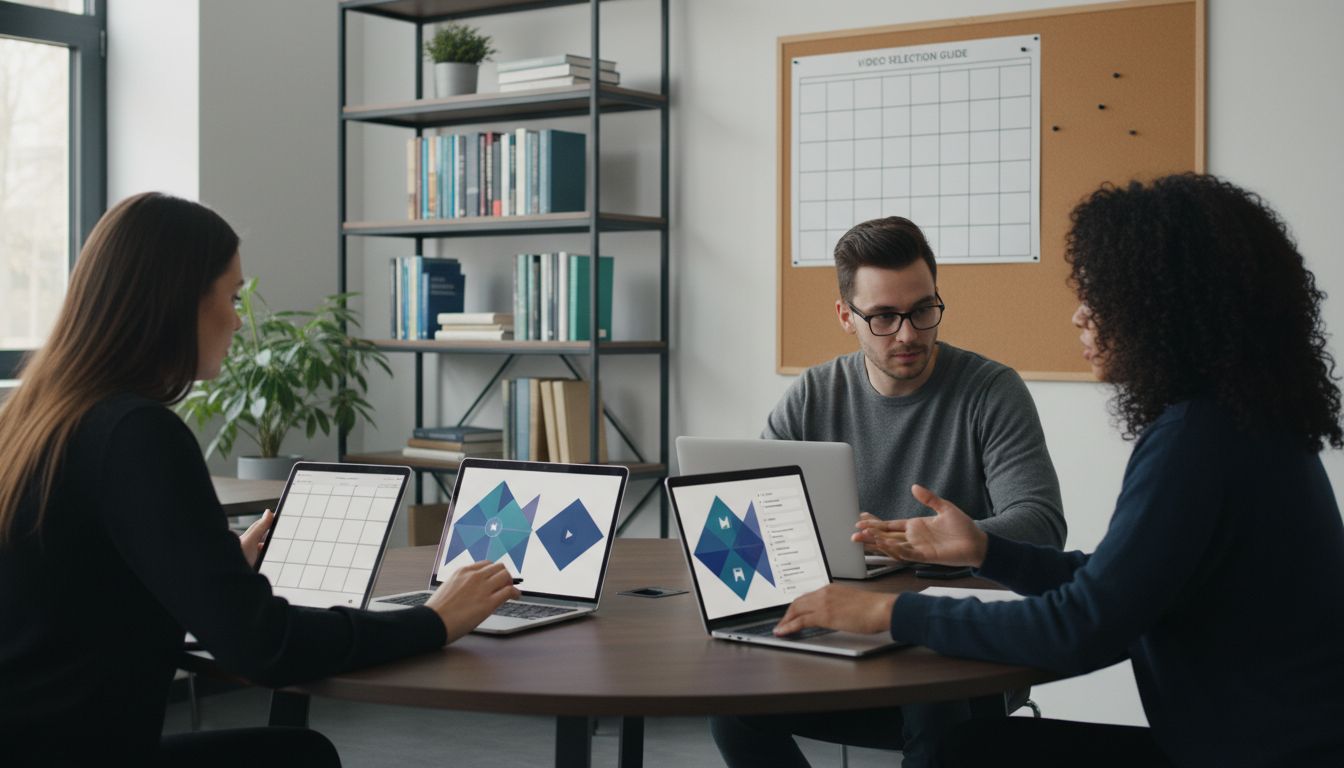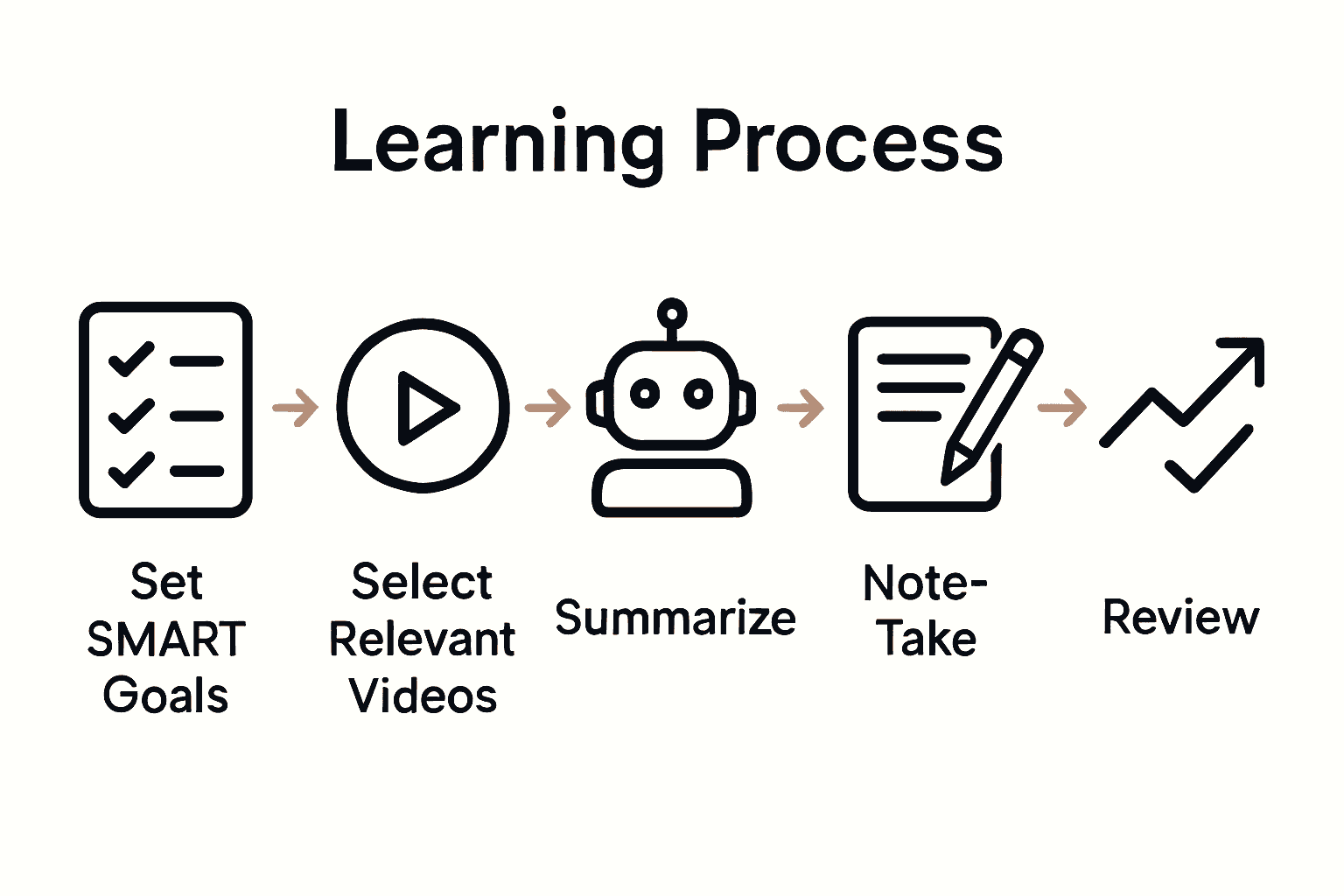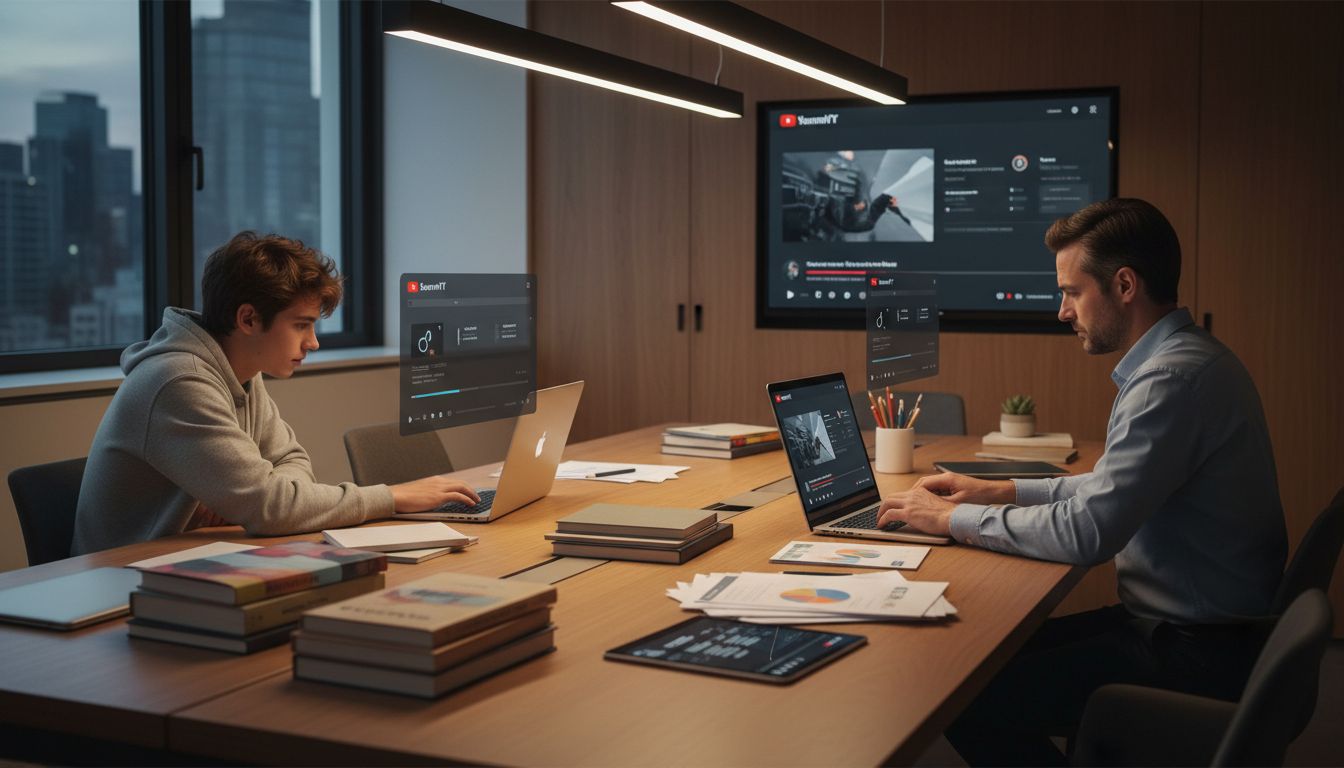How to Optimize Video Learning for Faster Comprehension

Over seventy percent of learners report higher retention when they set clear goals and use active strategies with video content. If you often catch yourself forgetting what you just watched online, you are not alone. Turning passive video viewing into real, lasting knowledge is possible with practical steps that guide you from selecting the right video to testing your understanding. Get ready to transform every video you watch into a powerful learning experience.
Table of Contents
- Step 1: Set Up Effective Learning Goals
- Step 2: Select and Prepare Relevant Video Content
- Step 3: Leverage SummYT to Summarize Key Insights
- Step 4: Apply Active Note-Taking and Annotation
- Step 5: Review and Test Your Retained Knowledge
Quick Summary
| Key Point | Explanation |
|---|---|
| 1. Set SMART Learning Goals | Establish specific, measurable, achievable, relevant, and time-bound goals to enhance your learning from videos. |
| 2. Choose Engaging Video Content | Select videos that align with your learning objectives and break down complex information into manageable parts. |
| 3. Utilize SummYT for Summarization | Use the SummYT tool to summarize videos efficiently, enabling you to focus on key insights quickly. |
| 4. Implement Active Note-Taking | Use structured notes and annotations to engage actively with the material, improving comprehension and retention. |
| 5. Regularly Review and Test Knowledge | Create self-assessment questions and use spaced repetition to reinforce learning and ensure long-term retention. |
Step 1: Set Up Effective Learning Goals
Your learning journey begins by crafting precise and actionable goals that transform video content into meaningful knowledge. By establishing clear objectives, you turn passive watching into active learning.
According to teachers.institute, effective learning goals should follow the SMART framework: Specific, Measurable, Achievable, Relevant, and Time-bound. This means moving beyond vague intentions like “learn something” to concrete targets such as “understand three key marketing strategies from this 45-minute business lecture within two hours”.
Start by asking yourself specific questions about what you want to gain from the video. Are you seeking technical skills? Conceptual understanding? Practical insights? Write down precise learning outcomes using action verbs like “define,” “analyze,” or “demonstrate” to create clear, measurable objectives.
Pro Tips for Goal Setting
- Break complex videos into smaller, digestible learning segments
- Set a realistic time frame for comprehending the material
- Create a quick note template matching your learning goals
- Plan how you will validate your understanding (quiz, summary, explanation to someone else)
By intentionally structuring your learning approach, you transform video content from background noise into targeted knowledge acquisition. Understand how summaries can aid your learning process to complement these goal-setting strategies and maximize your comprehension efficiency.
Step 2: Select and Prepare Relevant Video Content
Choosing the right video is crucial for efficient learning. Your goal is to find content that matches your learning objectives and provides clear, digestible information.
According to learnlight, effective video-based learning requires keeping content bite-sized and ensuring it remains interactive and relevant to your specific needs. This means avoiding lengthy lectures and prioritizing videos that break complex topics into manageable segments.
Start by scanning video descriptions, thumbnails, and comments to gauge content quality. Look for videos from credible sources like educational institutions, professional experts, or recognized industry leaders. Check the video length and ensure it aligns with your attention span and learning time frame.
Video Selection Checklist
- Verify presenter credentials and expertise
- Check video ratings and viewer feedback
- Confirm the content matches your learning goals
- Assess video production quality
- Preview first few minutes to evaluate teaching style

How to condense long videos can provide additional strategies for managing extensive learning materials. By thoughtfully selecting your video content, you set the foundation for an effective and engaging learning experience.
Step 3: Leverage SummYT to Summarize Key Insights
Turn lengthy videos into digestible knowledge with SummYT’s powerful AI summarization technology. Your goal is to extract maximum insights in minimum time.
Research from arxiv highlights how AI-based approaches can provide concise overviews that help learners make informed choices about content. By using SummYT, you transform complex video lectures into clear, actionable summaries that capture the most important information.
Start by copying the YouTube video URL into SummYT. The platform will automatically generate a comprehensive summary highlighting key points, main arguments, and critical takeaways. This process eliminates the need to watch entire videos repeatedly and helps you focus on the most valuable information.
Smart Summarization Tips
- Use the summary as a preview before watching the full video
- Compare the AI summary with your initial learning goals
- Take additional notes on areas that require deeper understanding
- Save summaries for future quick reference
Understanding why choose AI summarizers can provide additional insights into how these tools transform learning efficiency. With SummYT, you are not just watching videos you are strategically extracting knowledge.
Step 4: Apply Active Note-Taking and Annotation
Transform passive video watching into an engaging learning experience by mastering active note-taking techniques that boost comprehension and retention.
According to research from pmc, optimizing active learning in virtual platforms involves engaging learners through interactive elements to enhance comprehension. This means moving beyond simply watching videos to actively processing and documenting key information.
Begin by creating a structured note-taking template with sections for key concepts, questions, personal insights, and potential applications. Use different colors or symbols to categorize information quickly. Pause the video frequently to summarize main points in your own words, which helps reinforce learning and identify areas needing deeper understanding.
Pro Note-Taking Strategies
- Develop a consistent annotation system
- Write questions in margins to prompt critical thinking
- Use visual elements like mind maps or diagrams
- Highlight connections between different concepts
- Create summary statements after each video section
Video note-taking guide can provide additional techniques to refine your approach. Remember that effective note-taking is not about capturing every detail but about creating a personalized knowledge map that supports your learning goals.
Step 5: Review and Test Your Retained Knowledge
Validate your learning journey by implementing strategic review techniques that transform passive watching into active comprehension and long-term memory retention.
According to gocadmium, using analytics to continuously assess learner engagement helps improve knowledge retention. This means moving beyond simple watching to actively measuring and testing your understanding.
Begin by generating self assessment questions based on your notes. Create multiple formats including multiple choice, short answer, and conceptual explanation questions. Space out your review sessions to leverage the spacing effect experimental psychological principle that shows intermittent review improves long term memory storage.
Knowledge Verification Strategies
- Explain key concepts out loud without referencing notes
- Teach the material to an imaginary audience
- Create mind maps connecting different learned concepts
- Use online quiz tools to test comprehension
- Compare your understanding with original video summary
Why summaries boost retention can provide additional techniques to strengthen your learning approach. Remember that effective review is not about memorization but about developing genuine understanding and the ability to apply knowledge in different contexts.
Here’s a summary of the key steps for effective video-based learning:
| Step | Primary Action | Key Objective |
|---|---|---|
| Set Goals | Define SMART learning goals | Turn passive watching into active learning |
| Select Video | Choose relevant, engaging video content | Match content to your goals and enhance focus |
| Summarize | Use SummYT to condense key points | Extract actionable insights quickly |
| Note-Take | Apply structured annotation techniques | Boost comprehension and retention |
| Review | Test and verify your knowledge | Cement understanding for long-term retention |

|
Master Video Learning with SummYT for Faster Knowledge
The article highlights the challenges of turning lengthy videos into actionable knowledge and emphasizes the need for clear goals, effective summarization, and active engagement. If you’ve ever felt overwhelmed by the time it takes to watch full lectures or webinars, you are not alone. The pain points of inefficient video learning—long hours, loss of focus, and missed key points—are exactly what SummYT is designed to solve. With AI-powered summaries, you get precise, concise insights that align perfectly with your learning goals such as those described in How to Condense Long Videos and Understanding How Summaries Aid Learning.

Ready to transform your video learning experience? Visit SummYT now to start saving hours by getting instant, clear summaries for any YouTube educational content. Whether you’re a student, professional, or lifelong learner, SummYT helps you focus on what matters most. Don’t let long videos slow you down—embrace smarter learning today with SummYT!
Frequently Asked Questions
How can I set effective learning goals for video-based learning?
To set effective learning goals, apply the SMART criteria: Specific, Measurable, Achievable, Relevant, and Time-bound. For example, aim to “understand three key marketing strategies from a 45-minute lecture within two hours.” Write down your objectives using action verbs to clarify what you want to achieve.
What steps should I take to select the right video content for learning?
Choose video content that aligns with your specific learning objectives by verifying presenter credentials, checking video ratings, and assessing production quality. Prioritize videos that break down complex topics into bite-sized segments, ensuring they fit your attention span and learning time frame.
How do I use SummYT to enhance my video learning comprehension?
To enhance your comprehension, copy the video URL into SummYT to generate a concise summary of key points and takeaways. This allows you to extract maximum insights from lengthy videos quickly and saves time by focusing on what’s essential.
What are effective note-taking strategies for video learning?
Apply structured note-taking techniques by creating a template that includes sections for key concepts, questions, and personal insights. Use visual elements like color coding and mind maps to categorize information, and summarize main points in your own words as you watch.
How can I review and test my understanding after watching a video?
Validate your understanding by creating self-assessment questions based on your notes. Use a mix of formats like multiple choice and short answer questions, and space out your review sessions to improve long-term retention of the material.
What are the benefits of setting SMART goals for video learning?
Setting SMART goals for video learning helps you transition from passive watching to active engagement with the content. By defining measurable objectives, you can track your progress and ensure that you’re gaining meaningful knowledge from your video materials.



